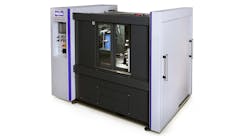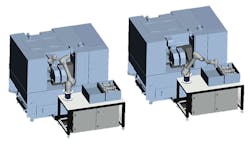EV Components Raise the Value of High-Precision Finishing
The onset of electric vehicle manufacturing has transformed automotive production – and thus the manufacturing of automotive components and systems, too. And as buyers face a wider selection of EVs, the e-vehicles’ performance becomes more important. This increases automotive suppliers’ demand for superfinishing technology.
Nagel Maschinen- und Werkzeugfabrik GmbH in Nürtingen, Germany, specializes in superfinishing systems, and its NaShaft series has been adopted by automotive supplier ZF Friedrichshafen AG’s finishing operation in Thyrnau, Germany, to process e-transmission shafts. "We are noticing that demand for our Superfinish technology is by no means slowing down with the trend toward e-mobility… on the contrary," explained Christian Feuchter, Nagel technical sales director. "The typical workpieces for combustion engines are becoming fewer but those for e-drives are increasing, especially transmission and rotor shafts.
“At the same time, machining requirements also are increasing,” he continued. “Other components also are on the rise regardless of the type of drive, including steering racks and nuts, for example."Evidence of this trend is provided by ZF Friedrichshafen, for which component finishing is an increasingly necessary manufacturing step thanks to the rising importance of e-mobility products. The aim is to increase the load-bearing capacity of each workpiece and to reduce short wavelengths.
E-drives, unlike combustion engines, generate very little noise during operation, but the surrounding bearing points become audible, issuing a whirring noise. This is caused by the waviness of the bearing journals, which is inevitably left after turning and grinding. Where components make themselves heard in this way, friction and losses are also higher.
As a consequence, e-drive manufacturers are raising their quality requirements for dimensional accuracy and surface finish. After all, electric vehicles are supposed to glide along as quietly as a whisper, without passers-by wondering about strange sounds. So, superfinishing is becoming a key technology in the production chains of e-drive components, because only superfinishing is capable of eliminating the ripples.
When ZF in Thyrnau recognized the expanding need for superfinishing capacity it committed to purchasing a new superfinishing center – the Nagel NaShaft Eco 612 machine.
"This machine proved to be the best system for our application," according to ZF’s process planner at Thyrnau. "It is loaded by a gantry loader through the roof hatch and will be fully integrated into a belt linking system at a later stage," he said, outlining the automation concept.
"The NaShaft series is a highly flexible machine platform with a modular design, and therefore it is a cost-effective solution. We manufacture this series as well as all other machines according to our high quality standards in Nürtingen," Christian Feuchter emphasized.ZF uses the NaShaft Eco 612 to process various transmission shafts with overall lengths from 150 to 380 mm, with bearing journals in the range of 30 to 60 mm diameter. Tension is applied between centers.
After grinding, the values for cylinder shape and surface finish are around 8 µm and Rz 2.5 µm. The targets for superfinishing are <5 µm and Rz <0.7 µm. Nagel developed a hybrid process for this task.
"There is a stone process and a tape process,” Christian Feuchter explained. “The stone process ensures an improvement of the waviness on the bearing journals, it therefore optimizes the cylinder shape or the shape accuracy. The subsequent tape process improves the surface quality."
The NaShaft Eco finishing center is equipped with four finishing modules. The shafts to be machined have two bearing locations. Consequently, both bearing journals can be machined simultaneously, first in the stone process, then in the tape process. The pure machining time for one shaft is 15 seconds.
"Our Superfinish center meets all the user's quality and productivity specifications,” Feuchter summarized. “The application example is proof that flexibility and a modular design are important criteria. In order to meet high quality requirements, it is not always necessary to have high specifications."
According to Nagel, the systems’ energy consumption is comparatively low. As energy costs rise and sustainable production gains more emphasis, this is an important decision criterion for many companies.
But there are other advantages, too: The modular design goes hand-in-hand with the use of standard components, and so short delivery times are available for the NaShaft series machines. And, operators can re-tool the machines at any time and adapt them to changing market needs.


